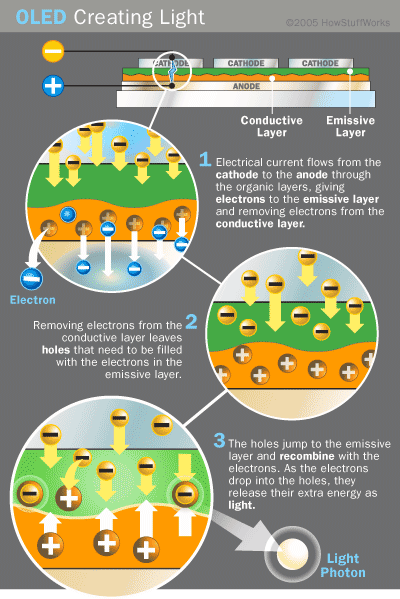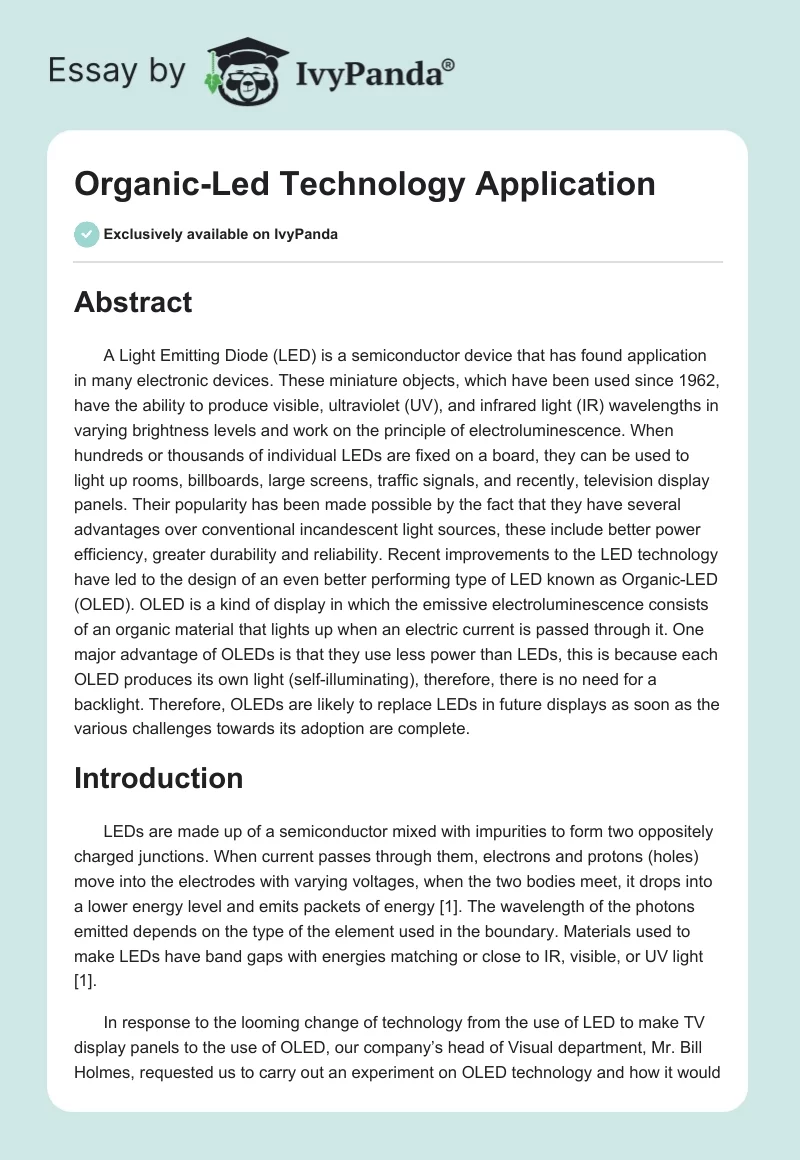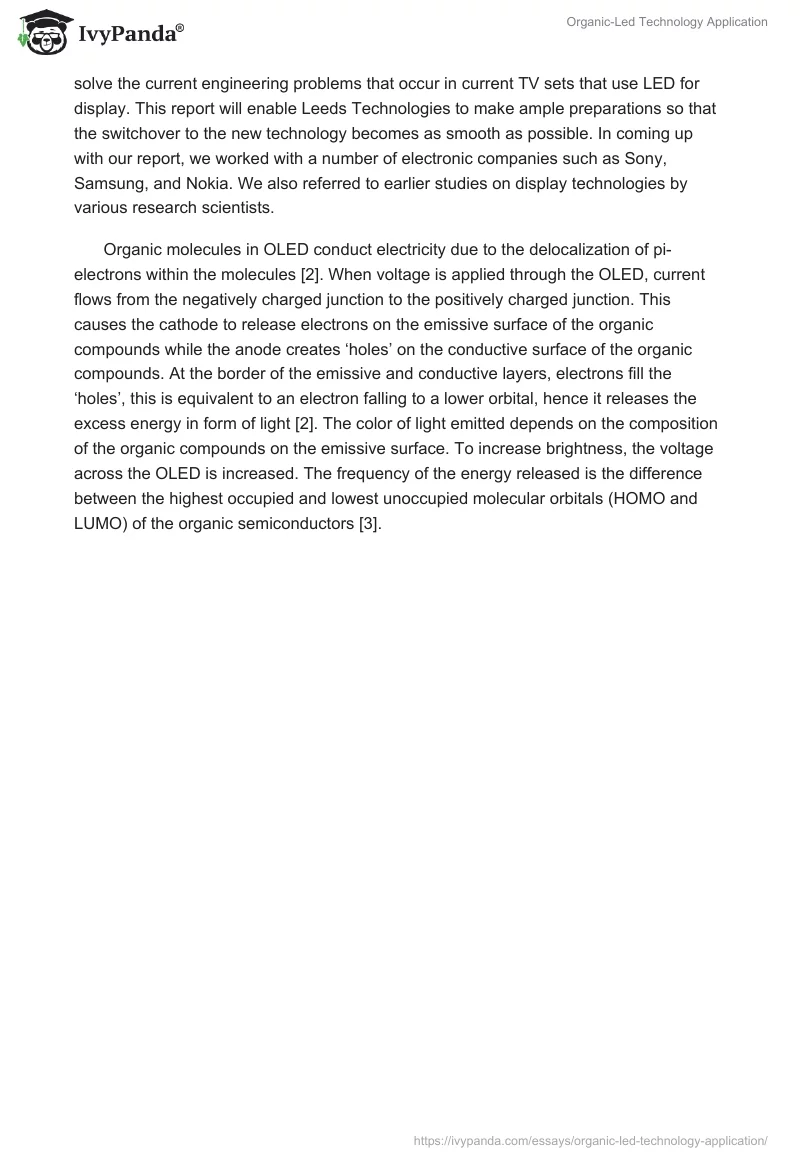Abstract
A Light Emitting Diode (LED) is a semiconductor device that has found application in many electronic devices. These miniature objects, which have been used since 1962, have the ability to produce visible, ultraviolet (UV), and infrared light (IR) wavelengths in varying brightness levels and work on the principle of electroluminescence. When hundreds or thousands of individual LEDs are fixed on a board, they can be used to light up rooms, billboards, large screens, traffic signals, and recently, television display panels. Their popularity has been made possible by the fact that they have several advantages over conventional incandescent light sources, these include better power efficiency, greater durability and reliability. Recent improvements to the LED technology have led to the design of an even better performing type of LED known as Organic-LED (OLED). OLED is a kind of display in which the emissive electroluminescence consists of an organic material that lights up when an electric current is passed through it. One major advantage of OLEDs is that they use less power than LEDs, this is because each OLED produces its own light (self-illuminating), therefore, there is no need for a backlight. Therefore, OLEDs are likely to replace LEDs in future displays as soon as the various challenges towards its adoption are complete.
Introduction
LEDs are made up of a semiconductor mixed with impurities to form two oppositely charged junctions. When current passes through them, electrons and protons (holes) move into the electrodes with varying voltages, when the two bodies meet, it drops into a lower energy level and emits packets of energy. The wavelength of the photons emitted depends on the type of the element used in the boundary. Materials used to make LEDs have band gaps with energies matching or close to IR, visible, or UV light.
In response to the looming change of technology from the use of LED to make TV display panels to the use of OLED, our company’s head of Visual department, Mr. Bill Holmes, requested us to carry out an experiment on OLED technology and how it would solve the current engineering problems that occur in current TV sets that use LED for display. This report will enable Leeds Technologies to make ample preparations so that the switchover to the new technology becomes as smooth as possible. In coming up with our report, we worked with a number of electronic companies such as Sony, Samsung, and Nokia. We also referred to earlier studies on display technologies by various research scientists.
Organic molecules in OLED conduct electricity due to the delocalization of pi-electrons within the molecules. When voltage is applied through the OLED, current flows from the negatively charged junction to the positively charged junction. This causes the cathode to release electrons on the emissive surface of the organic compounds while the anode creates ‘holes’ on the conductive surface of the organic compounds. At the border of the emissive and conductive layers, electrons fill the ‘holes’, this is equivalent to an electron falling to a lower orbital, hence it releases the excess energy in form of light. The color of light emitted depends on the composition of the organic compounds on the emissive surface. To increase brightness, the voltage across the OLED is increased. The frequency of the energy released is the difference between the highest occupied and lowest unoccupied molecular orbitals (HOMO and LUMO) of the organic semiconductors.

As mentioned earlier, LEDs have been widely used in the television industry for quite some time. These television sets use LEDs for backlighting rather than the conventional cold cathode fluorescent lamps (CCFL) tubes. The use of LED for backlighting has a dramatic effect on the design and performance of TVs; it results in the production of thinner display panels with low power consumption, and very much improved picture quality. Picture quality is in the form of improved contrast and a wider color gamut particularly when RGB dynamic LEDs are used. However, this technology has recently come under threat especially with the surfacing of OLEDs. Even though it does not solve all problems associated with LEDs, OLEDs have significantly improved the design, picture quality, price, and power consumption of television sets.
Viewing Angle and Picture Quality
Despite the technological advancements in the television industry, picture quality and viewing angle remains a major challenge for LED TV companies. In many instances, a customer purchases a LED television with the promise of ‘dynamic backlight’ and ‘dynamic color’; this is not usually the case when he finally gets a chance to view it. The explanation is quite simple, LED TVs display high-quality pictures when the viewer is positioned at the center, but when the position is shifted slightly to the left or right, the loss in image quality is noticeable. Consumer Reports TV ratings show that more than half of all LED TVs tested had a fair score regarding viewing angle, this is lower than the score recorded by the classic CRT TV sets.
We carried out experiments using several LED TV sets to determine the quality of the image with changes in the viewing angle and found out that as the position in front of the TV is shifted to the left or right, the display became dimmer and faded with a significant loss in brightness and color.
Another factor that affects image quality is contrast ratio, which is defined as the ratio of the white image brightness to that of the black color. The larger the value, the greater the contrast between black and white and hence the greater the picture quality. For example, a contrast of 10,000 implies that the brightest white is 10,000 times brighter than the darkest white on the display panel. This number varies between LED TVs. Most of the LED TV sets we used for the study had a contrast of 5000:1.
Picture quality is also affected by black levels. LED TVs produce images by selectively blocking light to pass from the LED-induced backlight. No matter the improvements, some light still reaches the display panel even when all the pixels should be black, compromising picture quality. This observation was evident during darkroom experiments to determine black levels as we could easily observe that true black color was not easy to achieve in LED TVs.
Power Consumption
Even though they are designed to consume low power, LED televisions are still not efficient as their OLED counterparts. Low power consumption in LEDs is only evident when they are compared to plasma and CRT TV sets. Our experiments showed that LED TVs can consume more than 500W of electricity for large screens. LED displays to reduce television power consumption by up to 50 percent, however, as temperatures increase when LEDs are lit, power consumption increases with prolonged usage. Even though our research showed that LED TVs had low energy consumption, it was no match for OLED TVs.
Another factor that contributes to higher power consumption is that the individual LEDs are powered by electricity, unlike OLEDs that are self-illuminating.
A Solution from OLED Technology
We found out that OLED TVs have an almost ideal viewing angle due to the simple fact that they create their own light, rather than blocking light. Every OLED produces its own light and this can be seen from various without distorting image quality.
Yersin mentions that OLED TVs excel when it comes to contrast and far exceed LED. For example, the new Sony OLED television, XEL-1, has a contrast of 1,000,000:1, while the highest rated LED TV’s contrast is 10,000:1. Since OLEDs do not require backlighting, it is easy to get black levels simply by reducing conductivity to the organic compounds, i.e. there is no need to block light as the OLEDs create their own light. This makes it possible to reach deep black levels that enhance picture quality. Bright colors require the most energy, therefore, to increase brightness, the power flowing through the OLEDs increases. LED display panels control brightness by either blocking or allowing the backlight to pass through the liquid crystals. This is a technical process, and even with the latest improvements, a few LED TV companies such as Sony and Sharp have achieved the 1000:1 contrast ratio.
Individual OLEDs contain red, green, and blue colors that work together to create multicolored images. This enables a more accurate representation of images on OLED display panels than LEDs. LEDs create different colors by altering light, the complexity of this process means that only a few companies can manufacture TVs that successfully separate the individual pixels.
We also observed that OLED TVs had a high refresh rate as compared to LED. Faster moving images such as those in high-speed video games and movies appeared blurry on the edges when using LED displays, OLEDs, however, have high refresh rates and this ensures that images appear sharp.
Power consumption in OLED TVs
OLED TV color is produced by organic molecules that emit light when current flows through them. No other source of light is required to energize these organic compounds, therefore, they have an absolutely low power consumption. The organic molecules used in OLEDs are emissive, on the contrary, LEDs require electric voltage to give off light. While power consumption in LED TVs peaked at 500 W, the highest, a comparison with similar OLED TV sets showed that the consumption was cut by an average figure of 60%, going as high as 80%. This will be a major boost to our customers in economical terms if we adopt OLED technology.
Conclusion
Our research and practical experiments have shown that OLED technology can be used to solve most of the engineering and technical problems that are present in TV sets that use LED technology. This technology can enable us to achieve contrast ratio and black level figures close to those of the plasma TVs. In addition, our TV sets will be much slimmer, have an improved picture quality, wider viewing angle, and above all, have low power consumption. Other advantages include higher refresh rates, faster response time, and lower production costs. This technology will enable us to expand our market share and achieve unprecedented growth. We, therefore, propose that the company change from LED to OLED technology so the company may stay a step ahead of its competitors.
Works Cited
Cristaldi, David J. R., Pulvirenti, Francesco, and Pennisi, Salvatore. Liquid Crystal Display Drivers: Techniques and Circuits. Rome: Springer, 2009.
Meller, Gregor, Grasser, Tibor. Organic Electronics. Berlin: Springer Heidelberg, 2010.
Howard, Brian Clark, Brinsky, William J., Leitman, Seth. Green Lighting. New York: McGraw-Hill, 2011.
Chimera, Fuji. Flat Panel Display Materials – Trends and Forecasts 2009 Edition. Redondo Beach, CA: InterLingua Technology Publishing, 2009.
Yersin, Hermut. Highly efficient OLEDs with phosphorescent materials. Weinheim: Willey VCH, 2009.
Shinar, Ruth, Shinar, Joseph. Organic electronics in sensors and biotechnology. New York: McGraw-Hill, 2009.


